- IB DP Biology 2025 SL- IB Style Practice Questions with Answer-Topic Wise-Paper 1
- IB DP Biology 2025 HL- IB Style Practice Questions with Answer-Topic Wise-Paper 1
- IB DP Biology 2025 SL- IB Style Practice Questions with Answer-Topic Wise-Paper 2
- IB DP Biology 2025 HL- IB Style Practice Questions with Answer-Topic Wise-Paper 2
C3.2 Defence against disease
Introduction
Pathogen: An agent that causes disease by infection, e.g. a living microorganism such as a
bacterium, a fungus or a virus.
e.g. Vibrio cholerae, Plasmodium, Mycobacterium tuberculosis, HIV virus, Variola viruses, Measles virus
Host: Organism infected by the pathoge
Disease: A pathological condition of a part, organ, or system of an organism resulting from
infection, genetic defect, or environmental stress, and characterized by an identifiable group of
signs or symptoms.
e.g. Cholera, Malaria, Tuberculosis, HIV/AIDS, Smallpox, Measles, Cardiovascular disease,
Cancer
Communicable/infectious disease: Disease that can pass from a diseased host to a healthy
organism. Endoparasite invades and grows inside host.
e.g. Cholera, Malaria, Tuberculosis, HIV/AIDS, Smallpox, Measles
Non-communicable/non-infectious disease: Disease that cannot pass from a diseased host to
a healthy organism
e.g. Cardiovascular disease, Cancer
Pathogen = an organism or virus that causes a disease

Archaea are not known to cause any disease in humans
Endemic: a disease that exists permanently in a particular region or population
Epidemic: an outbreak of disease that attacks many people at about the same time and may spread through one or several communities
Pandemic: When an epidemic spreads throughout the world = a worldwide epidemic
Avenues of attack for pathogens and toxins

⮚ Points of entry
– digestive system
– respiratory system
– urogenital tract
– break in skin
⮚ Routes of attack
– circulatory system
– lymph system
Self and Non-self
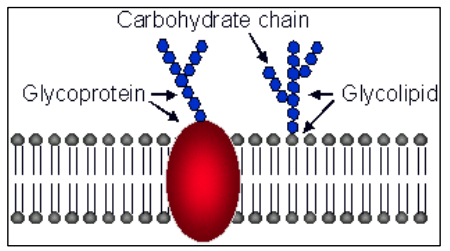
⮚ All organisms are different genetically
Except clones such as identical twins
⮚ Different proteins and glycoproteins on surface of cells
Specific for each individual
⮚ Body can (and needs to) distinguish between self and non-self
Self = molecules/cells belonging to the organism
Non-self = molecules/cells not belonging to the organism
System to distinguish self and non-self = Major histocompatibility complex (MHC)
⮚ All non-self molecules act as antigens = antibody-generating substances
“Signature” of the non-self
Induces Immune Response
Immune response = 1) Recognition of antigen by antibody
2) Production of a lot of this specific antibody
3) Antibodies help get rid of non-self
⮚ This response happens after exposure to the antigens
“Acquired” = “Adaptive” Immunity
Immune system: The integrated body system of organs, tissues, cells, and cell products such as antibodies that differentiates self from non-self and neutralizes potentially pathogenic organisms or substances.

Animals have three lines of defence to protect them against pathogens
If pathogen is successful in crossing a line of defence, it will face the next one
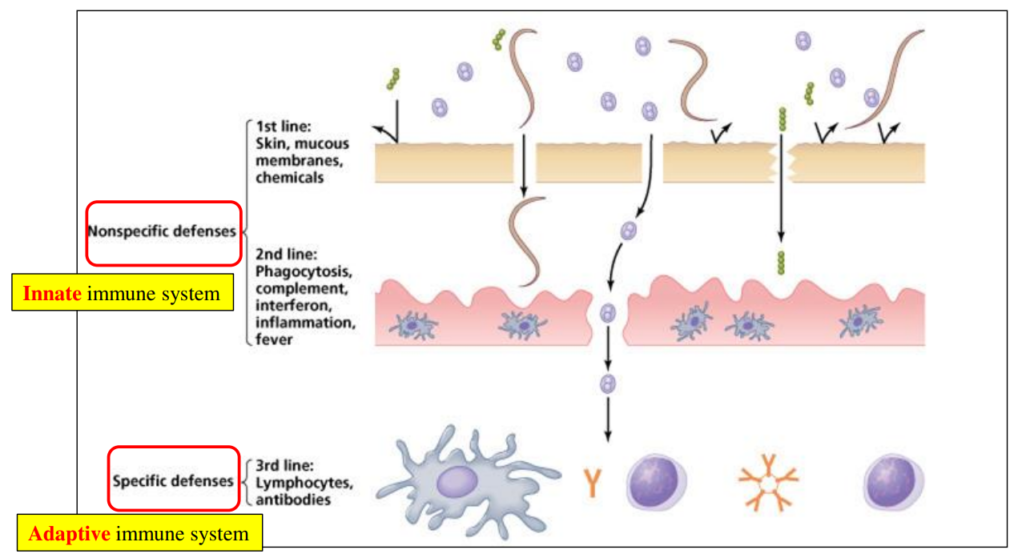
First line of defence
skin and mucous membranes
Animals have three lines of defence to protect them against pathogens
If pathogen is successful in crossing a line of defence, it will face the next one


Potential ports of entry for pathogens:
A – External skin
⮚ Outer layer = keratinised epithelium of dead cells
Tough and impervious layer
⮚ Infection may occur if outer layer is
– Broken
– Cut
– Deeply scratched
– Degraded by micro-organisms inside folds an creases
e.g. fungus causing athlete’s foot
e.g. Schistosomiasis


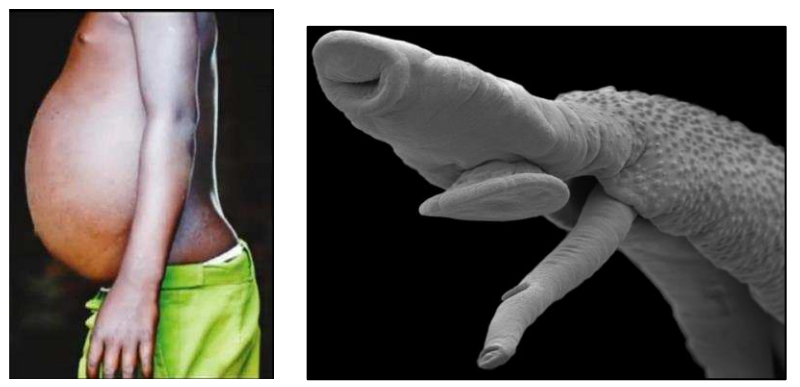
Potential ports of entry for pathogens:
B – Internal linings of breathing and digestive apparatuses
⮚ Internal lining of breathing apparatus = trachea, bronchi, bronchioles
Internal lining of digestive apparatus = oeasophagus, stomach, small and large intestines
⮚ No keratin layer as on skin
But lined by moist epithelia (sing. epithelium) = external, thin tissue layer
Epithelium itself vulnerable to pathogens
But protected by mucus secreted by goblet cells
⮚ In breathing apparatus, cilia move mucus that has trapped
pathogens and dust up to back of mouth
Swallowed and destroyed in stomach (pH 2 and protease)
⮚ In digestive apparatus, digestive enzymes provide protection against pathogens
Wall of stomach: gastric glands produce
gastric juice = HCl + precursors of proteases
e.g. Pepsinogen (inactive) activated into pepsin by low pH


Second line of defence
Phagocytosis and Blood clotting
Animals have three lines of defence to protect them against pathogens

⮚ If pathogen crosses the first line of defence
– Pathogen enters the body
– Second line of defence = white blood cells
⮚ Many kinds of WBC, i.e. Macrophages (= Phagocytes) and Lymphocytes
⮚ All cells have specific proteins on their surface
Cells of the body have self proteins on their surface
Pathogens have non-self proteins on their surface
Phagocytes recognize non-self
⮚ Change shape to engulf pathogen: phagocytosis

⮚ Macrophages and Neutrophils perform phagocytosis with pathogens
Phago = eating , cyto = cell , sis = process
⮚ Same for dead tissue cells and cell debris


Third line of defence
The immune response
Animals have three lines of defence to protect them against pathogens
If pathogen is successful in crossing a line of defence, it will face the next one

B-lymphocytes and T-lymphocytes
Lymphocytes: Any of the nearly colorless cells found in the blood, lymph, and lymphoid tissues, constituting approximately 25 percent of white blood cells and including B cells, which function in humoral immunity, and T cells, which function in cellular immunity.

Newly formed lymphocytes are all alike
But they later develop into B cells or T cells
Depending on where they continue their maturation

B Lymphocytes
• Attack, learn & remember pathogens circulating in blood & lymph
• Produce specific antibodies against specific antigen • Types of B lymphocytes cells
• Types of B lymphocytes cells
– Plasma cells
• immediate production of antibodies
• rapid response, short term release
– Memory cells
• continued circulation in body
• long term immunity
⮚ Antibodies are present on the surface of B lymphocytes
⮚ When an antigen is recognised by the immune system,
The corresponding antibodies are released into the blood stream

Antigens
 An MHC marker labels the body’s cells as “self”
An MHC marker labels the body’s cells as “self”
Major Histocompatibility Complex
 An antigen is a molecule that the immune system recognizes as non-self
An antigen is a molecule that the immune system recognizes as non-self
Antigens and antibodies
• Antigen = any NON-SELF molecule
• An antibody recognizes and binds to a small, accessible portion of
the antigen = epitope
• One given antigen can have more than one different epitopes

⮚ An antibody is made of two pairs of proteins
Antibody = 2X Heavy chain + 2X Light chain
⮚ Two regions: Constant region + Hypervariable region
Hypervariable region = site of recognition of antigen
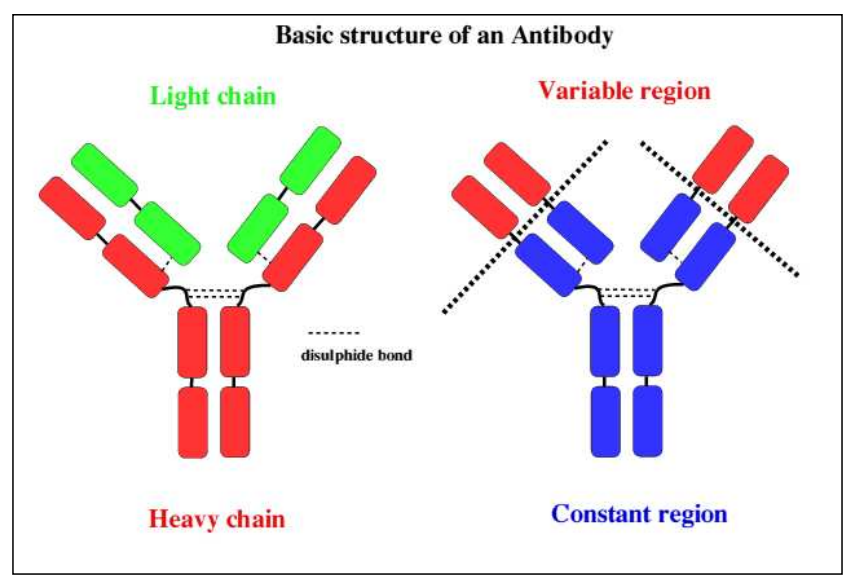
One antibody is specific for one given antigen

Antibody production

B lymphocytes activation

1. Among all Ab present,
Antibody anti-X recognizes Antigen X
2. THE B lymphocyte with
Ab anti-X activated
3. Proliferates
Makes a clone
Each B lymphocyte of
this clone presents Ab anti-X
4. Response specific to Ag X

Antigen identified
↓
B- lymphocyte is identified that can produce the antibody that will bind to the antigen
↓
The B lymphocyte clone themselves
↓
They begin the antibody production
↓
These antibodies circulate in the bloodstream .
↓
Find the antigen and eliminates the pathogen
↓
Some of B- cells remain as Memory cells


B lymphocytes activation
• “Anti-self” B lymphocytes are destroyed before Clonal Selection
– This has to occur since the antigen receptors are formed from RANDOM gene rearrangements
– Could accidentally produce a receptor that recognizes a body cell/molecule
– Autoimmune diseases result when clonal selection fails

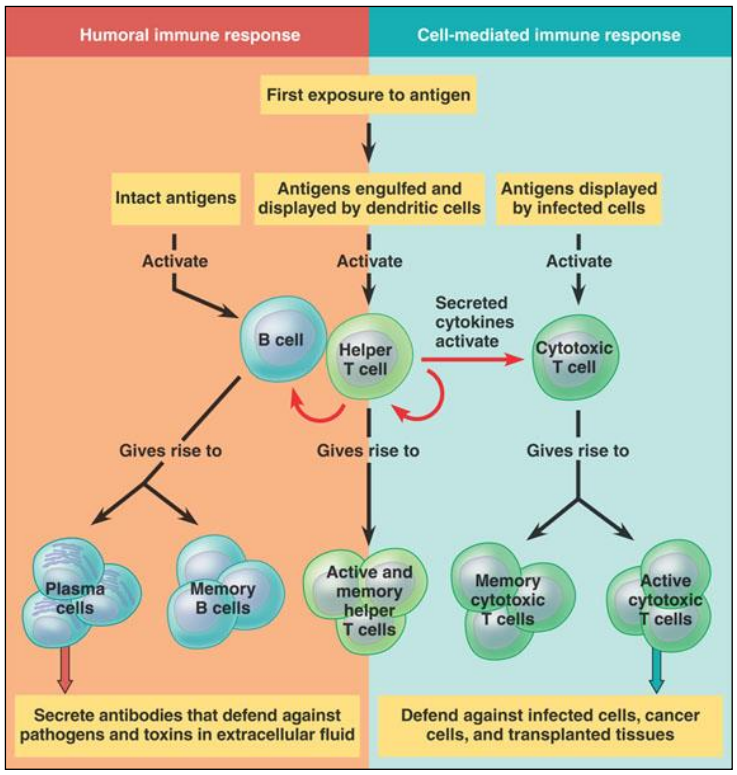

Primary Response
⮚ Initial immune response to antigen
⮚ Clonal selection of B and T cells
⮚ Carried out by newly made clones of B and T cells
⮚ B and T Memory cells are produced and kept
Secondary Response
⮚ Immune response when exposed to the same antigen a second time
⮚ Starts with Memory cells
⮚ Memory cells are more numerous than initial B and T cells of the clonal selection during primary immune response
– Secondary immune reponse
Faster and Stronger than
Primary immune response


Days to years
Between first and second infection
⮚ Secondary immune response is faster and stronger than primary immune response
– Body will be protected = immune to pathogens

Active immunity: the body is exposed to antigens, and produces antibodies against antigens
Passive immunity: the body receives antibodies produced elsewhere
Natural immunity: in “real life”
Artificial immunity: with the help of doctors/nurses for injection of antigens or antibodies


Active: your body produces Ab because it responds to Ag
Passive: your body receives Ab
Vaccination
⮚ Secondary immune response is faster and stronger than primary immune response
Idea = make immune responses secondary immune responses, not primary
Especially towards pathogens that we expect to be infected by
– Body will be protected = immune to pathogens
How ?
⮚ Expose body to antigen deliberately
– Antigen will trigger primary immune response
Production of memory cells
– Any succeeding infection by same antigen will trigger secondary immune response thanks to memory cells

Vaccines are made up of weakened or parts from viruses or microbes
Vaccination = Immunization
Makes an individual develop immunity to an antigen without actually getting “sick” during initial exposure
Vaccination: Body produces adequate memory cells
Further infection: Body responds quickly thanks to already present memory cells
Conclusion: Vaccination protects from contracting disease
Bring antigen, but do not cause disease
⮚ Dead bacteria
⮚ Attenuated bacteria: divide very slowly
⮚ Inactivated virus: cannot infect and kill target cells
Is the antigen By itself, cannot cause disease
⮚ Purified polysaccharides from bacterial cell walls
⮚ Toxoid: molecule of toxin made inactive by chemical or heat treatment
Is not an antigen per se, but body will Identify as such
⮚ Recombinant DNA vaccine: mimics the virus’ DNA
⮚ Some memory cells last all our life
– Protection lasts a lifetime
⮚ Some memory cells 1) last just a few years / 2) not generated in enough quantities
– Protection decreases/disappears
Need to get vaccinated 1) again / 2) several times
Vaccine booster

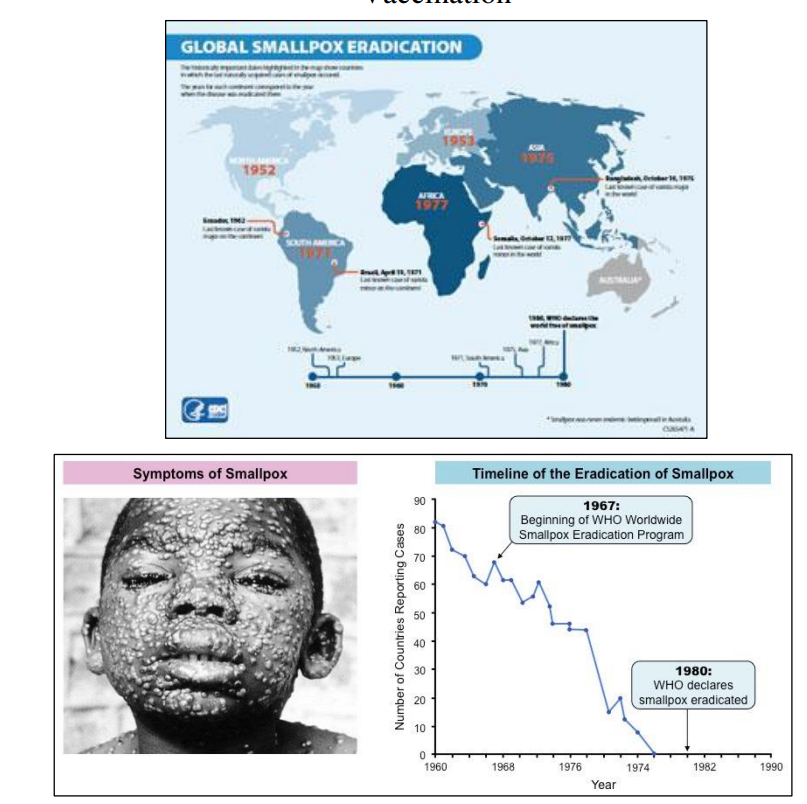
Analysis of epidemiological data related to vaccination programmes

Immunities: innate, adaptive, herd
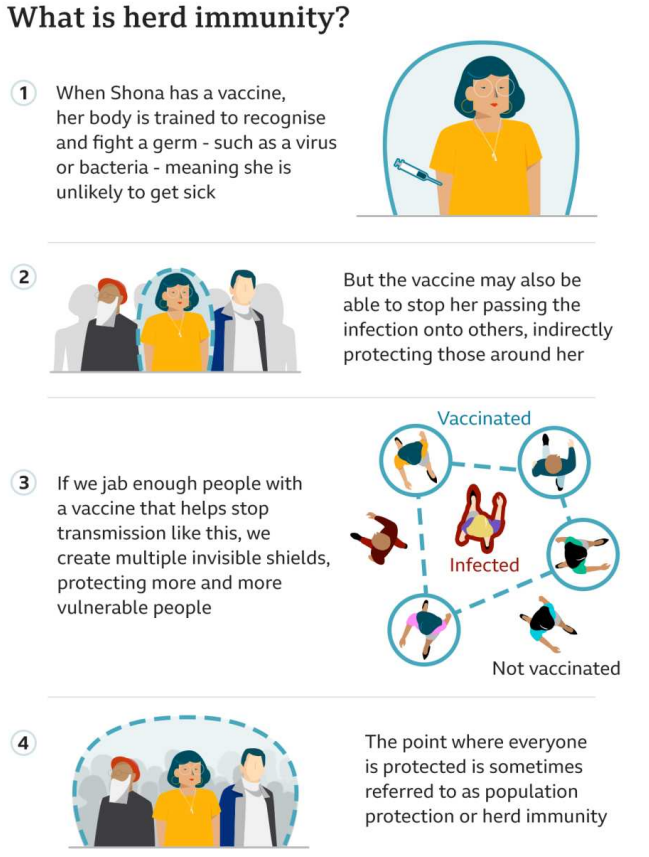

Antibiotics
Antibiotic : anti life
– Only living organisms are affected by ATB
Viruses are NOT targets of ATB
Most ATB target bacterial pathogens
Prokaryotes (bacteria) and eukaryotes show differences in metabolism
– ATB take advantages of these differences
– ATB are specific for prokaryotic metabolic processes
Antibiotics = chemicals that can kill or damage prokaryotic cells but not eukaryotic cells
Antibiotics can be
- bactericidal (kill bacteria)
- bacteriostatic (making bacteria inactive)
Targets of Antibiotics

Sources of Antibiotics
⮚ Many antibiotics discovered in saprotrophic fungi
In nature, they compete with bacteria for nutrients
Excrete antibacterial antibiotics
Culture the fungi + extract ATB
⮚ Some are extracted from bacteria or chemically synthesized

Testing Penicillin
Stage 1:Growing the penicillin
This was a combination of the latest freeze-drying technology and some much more traditional
equipment: thousands of milk bottles (in which to grow the bacteria), milk churns, a dog bath and a
hand pump! From this, the team were able to gather a few grams of pure penicillin.
↓
Stage 2: Testing penicillin on animals
There was enough penicillin to test it on eight mice. They were injected with a deadly bacteria
(streptococci). Four of the mice were then given penicillin. 24 hours later the mice which had not
been injected with penicillin were dead. Those who had been injected were healthy.
↓
Stage 3: The first human trial of penicillin
By 1941 the team had enough penicillin to test it on a human. The patient had terrible abscesses
which had spread from his mouth to his scalp, eyes, arm and even his lung. He was going to die –
there was nothing to lose by trying penicillin. After four days of treatment he was much improved and was sitting up in bed – penicillin worked. However, they did not have enough, and after five days the supply ran out – the patient relapsed and died.
Resistance to Antibiotics



Required measures
⮚ Doctors prescribe ATB only for serious bacterial infections
⮚ Patients complete full courses of ATB to eliminate the infections completely
⮚ High hygiene standards maintained in hospitals to prevent cross-infections
⮚ Farmers not using ATB in animals feeding
⮚ Develop new ATB, e.g. searching chemical libraries (next )

HIV and AIDS
HIV = Human Immunodeficiency Virus
AIDS = Acquired Immunodeficiency Syndrome
1. HIV invades and destroys T-Helper cells
2. Capacity to produce antibodies eventually lost
3. Susceptibility to “opportunistic” pathogens
4. Syndrome = more sensitive to multiple concomitant diseases some are typical of latter stages of AIDS, i.e. Kaposi’s sarcoma
Early infection: body produces anti-HIV antibodies
Detection of antibodies: “HIV-positive”

Most efficient drugs against HIV are antiretroviral drugs
Anti-fusion
Anti-integrase
Anti-maturation
Reverse transcriptase inhibitors
Transmission of HIV:
⮚ Sexual intercourse: abrasions mucous membranes penis/vagina causing minor bleeding
⮚ Transfusion of contaminated blood
⮚ Placenta/childbirth/breastfeeding
⮚ Sharing hypodermic contaminated needles
Rare minorities of individuals do not have cell receptors for HIV on their Helper T-cells and do not develop AIDS

Zoonoses and COVID-19
A zoonosis is an infectious disease that has jumped from a non-human animal to humans
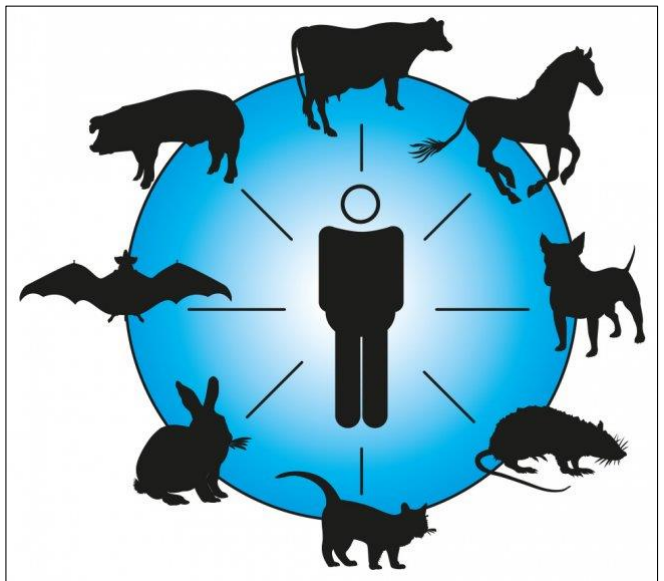

Although the primary reservoir of influenza , A viruses is the aquatic birds of the world, stable lineages are present in other hosts such as humans. Analysis of the receptor-binding preferences of viruses from each of these hosts has shown that human and avian viruses have preferences for different conformations of the cellular receptor, sialic acid. Because of this, viruses adapted to humans replicate in and transmit well to other humans, but poorly to aquatic birds. Conversely, viruses adapted to aquatic birds replicate in and transmit well to other aquatic birds, but poorly to humans. Swine seem to be unique in terms of influenza A ecology and show an intermediate susceptibility to both human and avian viruses


Calculate:
1. Percentage differences
2. Percentage changes
Between 27-08-20 and 19-11-20
And Between 19-11-20 and 11-02-21
1. Percent difference = \(\frac{|value 1 – value 2|}{\frac{value 1+value 2}{2}} \times 100\)
2. Percentage Change = \(\frac{New \;value – Old\;value}{Old\;value} \times 100%\)
If the result is positive , it is an increase
if the result is negative, it is a decrease